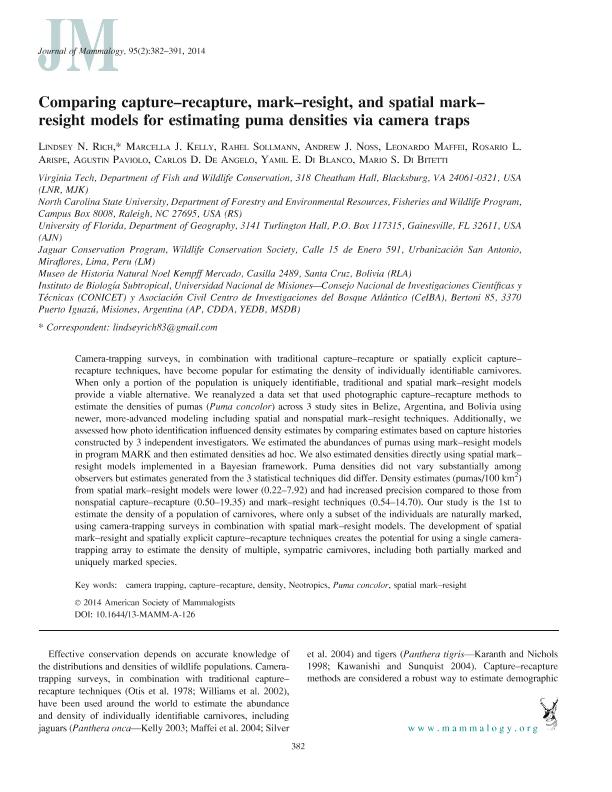Mostrar el registro sencillo del ítem
dc.contributor.author
Rich, Lindsey N.
dc.contributor.author
Kelly, Marcella J.
dc.contributor.author
Sollmann, Rahel
dc.contributor.author
Noss, Andrew

dc.contributor.author
Maffei, Leonardo
dc.contributor.author
Arispe, Rosario L.
dc.contributor.author
Paviolo, Agustin Javier

dc.contributor.author
de Angelo, Carlos Daniel

dc.contributor.author
Di Blanco, Yamil Edgardo

dc.contributor.author
Di Bitetti, Mario Santiago

dc.date.available
2019-05-15T19:45:22Z
dc.date.issued
2014-04
dc.identifier.citation
Rich, Lindsey N.; Kelly, Marcella J.; Sollmann, Rahel; Noss, Andrew; Maffei, Leonardo; et al.; Comparing capture-recapture, mark-resight, and spatial mark-resight models for estimating puma densities via camera traps; Alliance Communications Group Division Allen Press; Journal of Mammalogy; 95; 2; 4-2014; 382-391
dc.identifier.issn
0022-2372
dc.identifier.uri
http://hdl.handle.net/11336/76450
dc.description.abstract
Camera-trapping surveys, in combination with traditional capture-recapture or spatially explicit capture-recapture techniques, have become popular for estimating the density of individually identifiable carnivores. When only a portion of the population is uniquely identifiable, traditional and spatial mark-resight models provide a viable alternative. We reanalyzed a data set that used photographic capture?recapture methods to estimate the densities of pumas (Puma concolor) across 3 study sites in Belize, Argentina, and Bolivia using newer, more-advanced modeling including spatial and nonspatial mark?resight techniques. Additionally, we assessed how photo identification influenced density estimates by comparing estimates based on capture histories constructed by 3 independent investigators. We estimated the abundances of pumas using mark-resight models in program MARK and then estimated densities ad hoc. We also estimated densities directly using spatial mark?resight models implemented in a Bayesian framework. Puma densities did not vary substantially among observers but estimates generated from the 3 statistical techniques did differ. Density estimates (pumas/100 km2) from spatial mark-resight models were lower (0.22-7.92) and had increased precision compared to those from nonspatial capture-recapture (0.50-19.35) and mark-resight techniques (0.54-14.70). Our study is the 1st to estimate the density of a population of carnivores, where only a subset of the individuals are naturally marked, using camera-trapping surveys in combination with spatial mark-resight models. The development of spatial mark-resight and spatially explicit capture-recapture techniques creates the potential for using a single cameratrapping array to estimate the density of multiple, sympatric carnivores, including both partially marked and uniquely marked species.
dc.format
application/pdf
dc.language.iso
eng
dc.publisher
Alliance Communications Group Division Allen Press

dc.rights
info:eu-repo/semantics/openAccess
dc.rights.uri
https://creativecommons.org/licenses/by-nc-sa/2.5/ar/
dc.subject
CAMERA TRAPPING
dc.subject
CAPTURE-RECAPTURE
dc.subject
DENSITY
dc.subject
NEOTROPICS
dc.subject
PUMA CONCOLOR
dc.subject
SPATIAL MARK-RESIGHT
dc.subject.classification
Otras Ciencias Biológicas

dc.subject.classification
Ciencias Biológicas

dc.subject.classification
CIENCIAS NATURALES Y EXACTAS

dc.title
Comparing capture-recapture, mark-resight, and spatial mark-resight models for estimating puma densities via camera traps
dc.type
info:eu-repo/semantics/article
dc.type
info:ar-repo/semantics/artículo
dc.type
info:eu-repo/semantics/publishedVersion
dc.date.updated
2019-05-10T14:09:00Z
dc.identifier.eissn
1545-1542
dc.journal.volume
95
dc.journal.number
2
dc.journal.pagination
382-391
dc.journal.pais
Estados Unidos

dc.journal.ciudad
Lawrence
dc.description.fil
Fil: Rich, Lindsey N.. Virginia Polytechnic Institute And State University; Estados Unidos
dc.description.fil
Fil: Kelly, Marcella J.. Virginia Polytechnic Institute And State University; Estados Unidos
dc.description.fil
Fil: Sollmann, Rahel. North Carolina State University; Estados Unidos
dc.description.fil
Fil: Noss, Andrew. University of Florida; Estados Unidos
dc.description.fil
Fil: Maffei, Leonardo. Wildlife Conservation Society; Perú
dc.description.fil
Fil: Arispe, Rosario L.. Museo de Historia Natural Noel Kempff Mercado; Bolivia
dc.description.fil
Fil: Paviolo, Agustin Javier. Consejo Nacional de Investigaciones Científicas y Técnicas. Centro Científico Tecnológico Conicet - Nordeste. Instituto de Biología Subtropical. Universidad Nacional de Misiones. Instituto de Biología Subtropical; Argentina
dc.description.fil
Fil: de Angelo, Carlos Daniel. Consejo Nacional de Investigaciones Científicas y Técnicas. Centro Científico Tecnológico Conicet - Nordeste. Instituto de Biología Subtropical. Instituto de Biología Subtropical - Nodo Puerto Iguazú | Universidad Nacional de Misiones. Instituto de Biología Subtropical. Instituto de Biología Subtropical - Nodo Puerto Iguazú; Argentina
dc.description.fil
Fil: Di Blanco, Yamil Edgardo. Consejo Nacional de Investigaciones Científicas y Técnicas. Centro Científico Tecnológico Conicet - Nordeste. Instituto de Biología Subtropical. Instituto de Biología Subtropical - Nodo Puerto Iguazú | Universidad Nacional de Misiones. Instituto de Biología Subtropical. Instituto de Biología Subtropical - Nodo Puerto Iguazú; Argentina
dc.description.fil
Fil: Di Bitetti, Mario Santiago. Consejo Nacional de Investigaciones Científicas y Técnicas. Centro Científico Tecnológico Conicet - Nordeste. Instituto de Biología Subtropical. Universidad Nacional de Misiones. Instituto de Biología Subtropical; Argentina
dc.journal.title
Journal of Mammalogy

dc.relation.alternativeid
info:eu-repo/semantics/altIdentifier/url/http://www.bioone.org/doi/abs/10.1644/13-MAMM-A-126
dc.relation.alternativeid
info:eu-repo/semantics/altIdentifier/doi/http://dx.doi.org/10.1644/13-MAMM-A-126
Archivos asociados
